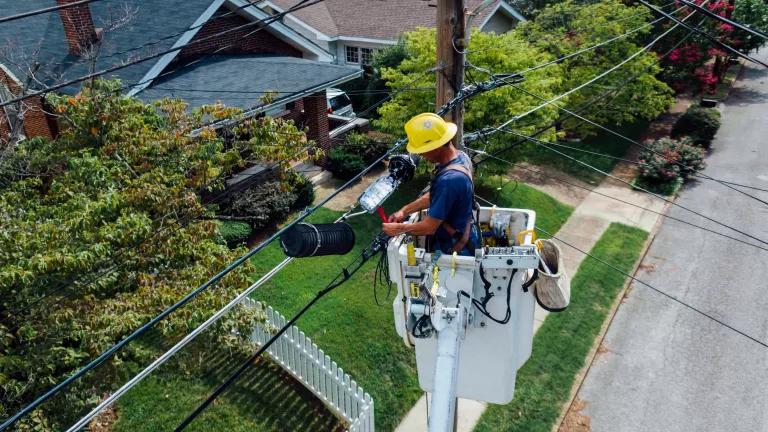
This blog post was authored by Rachel Fakhry, MAP Fellow and participant in the DOE negotiated rulemaking.
As they say, things don't always go as planned. But this doesn't preclude a happy ending because an important agreement has now been approved that will affect the energy efficiency of the large refrigerated coolers and freezers found in almost every restaurant, supermarket, and convenience store in the country - saving billions of dollars and kilowatt-hours of electricity.
Once they go into effect, the amended energy conservation standards for six refrigeration classes of walk-in coolers and walk-in freezers (collectively known as "walk-ins" or WICFs) used in the food service and food sales industry to temporarily store frozen food and perishable goods will deliver significant benefits to businesses through energy bill savings and because they will lessen the need to use fossil fuels to burn electricity, they will help curb the harmful impacts of climate change.
The action came just one day after energy efficiency standards for commercial rooftop air conditioners, heat pumps and warm air furnaces were announced, representing the most energy and pollution savings under any energy-saving rule issued since the U.S. Department of Energy (DOE) standards program began in 1987.
Like the huge efficiency standard announced last week, the agreement for walk-in refrigeration products followed a successful negotiated rulemaking by the DOE, industry representatives, and energy efficiency advocates. The agreement was approved late last Friday by the Appliance Standards and Rulemaking Federal Advisory Committee (ASRAC), which provides advice and recommendations to DOE as a means to further improve energy efficiency standards.
Amending the standards for the six refrigeration classes by way of a negotiated rulemaking was part of the settlement agreement reached back in July by the Air-Conditioning, Heating, and Refrigeration Institute (AHRI) and DOE. The negotiations included consensus amended standards for the six refrigeration classes, together with a number of recommendations to DOE related to these classes.
The six new standards for walk-ins alone will save approximately 80 billion kilowatt-hours over 30 years of sales, which is equivalent to the annual electricity use of about 7 million U.S. households. The standards will also save businesses up to $4 billion during that period. Considering that this equipment lasts for over 12 years, improving its efficiency saves money for businesses for many years to come. Adding these six amended standards back into the larger rule finalized last year is expected to generate similar economic and environmental benefits--avoiding nearly 159 million metric tons of harmful carbon emissions and saving businesses between $3.98 and $9.9 billion over 30 years of sales.
So what's the back story?
As I mentioned above, in June 2014, DOE prescribed updated component-level energy efficiency standards for walk-ins: this means that it established separate standards for the three major components that comprise walk-ins - i.e. doors, panels and refrigeration systems. Collectively, the rule comprised 19 separate energy standards for the three components: 10 standards for the 10 refrigeration classes and 9 standards for panels and doors.
In August 2014, AHRI (the trade association representing manufacturers of air conditioning, heating and commercial refrigeration equipment) petitioned for review of the new efficiency standards. Simultaneously, parties challenged the final rules in court, which resulted in a settlement agreement between DOE and AHRI members, whereby DOE supported a negotiated rulemaking process to discuss and amend efficiency standards for six of the 10 refrigeration classes. In August 2015, the U.S. Court of Appeals vacated the six standards included in the June 2014 rule. The remaining 13 standards prescribed in the June 2014 final rule relating to panels, doors, and the remaining refrigeration classes remained unchanged.
What did the process look like?
In initiating the negotiated rulemaking process to amend the standards in question, DOE provided the adequate and necessary resources to ensure a successful completion of the process. It returned to the drawing board and collaborated with a working group of industry and advocates (including NRDC) to develop six standards on which all parties could agree. The analysis verified that there were hugely cost-effective options and thus all parties were interested in moving the process quickly, which made a negotiated rulemaking the preferred approach for amending these standards.
Given the controversy surrounding these standards just four short months ago, this is a huge win for energy efficiency and a testament to the effectiveness of negotiated rulemakings for working through complex and challenging concerns.
During thirteen meetings spanning over three months, industry and advocates had the chance to actively contribute to the analysis underpinning the final efficiency standards, voicing their concerns as well as providing data and their parties' perspective. The process ended with consensus including the following details:
- Updated Annual Walk-in Energy Factors (a measure of the efficiency of walk-ins) for the six refrigeration classes:
- Two standards applicable to multiplex condensing refrigeration systems operating at medium and low temperatures
- Four standards applicable to dedicated condensing refrigeration systems operating at low temperatures).
- These new standards will take effect three years after the rule if finalized.
- Definitions for walk-ins components (three types of condensing units) and a defrost process (adaptive defrost). Given the technical complexity of walk-ins, these definitions are meant to ensure proper compliance with the standards and avoid any confusion.
- Recommendations for future test procedure considerations- namely testing for adaptive defrost and rating variable capacity condensing units to ensure that future standards capture the potential savings from ever-improving technologies.
Indeed, 2015 concludes with a happy ending for walk-ins. Compliance with the final rule is expected to be smooth, given the significant contribution of industry and affected stakeholders to bring this to a successful resolution.



